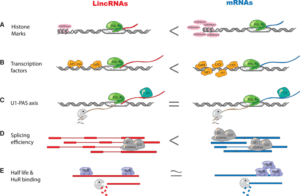In the whole human genome, only <3% of genomic DNA is transcribed into mRNAs that code for proteins, while >80% of genomic DNA is transcribed into RNAs that do not encode proteins and are referred to as non-coding RNA (ncRNAs). These ncRNAs transcripts were previously considered as ‘junk’ in the genome. ncRNAs are categorized based on their size, into small and long non-coding RNAs (lncRNAs >200 nucleotides in length).
Santanu et al., aimed to understand the variations of cellular responses and pathogenesis between HIV-1 and HIV-2 infections in Monocyte Derive Macrophages (MDMs). This was done by analyzing expression profiles of long intergenic non-coding RNAs (lincRNAs) and mRNAs in MDMs infected with HIV-1/HIV-2 using microarrays. The study identified many novel differentially expressed lincRNAs and mRNAs between HIV-1/HIV-2 infected MDMs compared to uninfected MDMs. They suggested that these differentially expressed lincRNAs and mRNAs could serve as prognostic and diagnostic biomarkers of HIV infection and help in the identification of new targets for therapy.
Further analysis using the GO and KEGG pathway comparison of differential regulation of mRNAs between HIV-1 and HIV-2 showed that different pathways and functions are involved in the macrophage response to HIV-1 and HIV-2 infection 7 days post infection. Santanu et al., pointed out that very few enriched GO terms and pathway terms were shared between HIV-1/HIV-2 infected MDMs. Therefore, HIV-1 and HIV-2 may evade host defence forces using different pathways. Of note, genes involved in glutathione metabolism, lysine degradation and olfactory transduction, were differentially down regulated in HIV-1 infected MDMs. However, more genes (>100) were differentially upregulated in MDMs infected with HIV-2; specifically genes for proteins such as CUL 2, SFRS9 and RBBP4.
The study identified two lincRNAs, lincRNA: chr2: 165509129-165519404 and lincRNA: chr12:57761837-57762303 that would be used as potential host biomarkers of HIV-1 infection. Similarly, lincRNA: chr10:128586385-128592960, XLOC_001148 and lincRNA: chr5:87580664-87583451, were identified as potential host biomarkers for HIV-2 infection. They further found that lincRNA: chr5:87580664-87583451, lincRNA: chr12:57761837-57762303 and XLOC_001148 could discriminate between HIV-1/HIV-2 infection and may serve as novel host biomarkers that could differentiate between HIV-1/HIV-2 infected patients.
In conclusion, the study demonstrated that there is substantial alteration in lincRNA and mRNA expression induced by HIV-1/HIV-2 infection, suggesting that these host factors may serve as potential biomarkers of infection and aid in the identification of new targets for therapy, prognosis and diagnosis.
Journal Article: Santanu et al., 2018. Differentially Expressed Host long intergenic noncoding RNA and mRNA in HIV-1 and HIV-2 Infection. Scientific Reports
Article by Christopher Kintu












